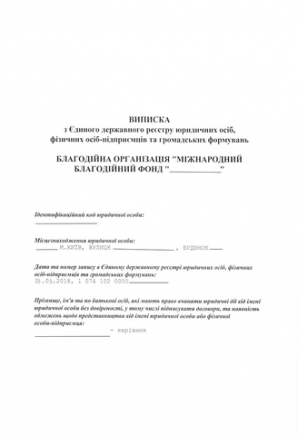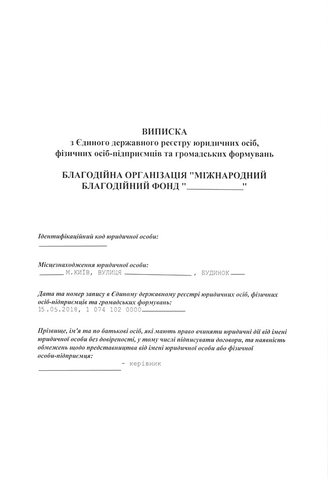How to prepare an annual report of a charitable foundation in Ukraine?
Cost of services:
Reviews of our Clients
The outcome of any activity is the results of the work. Each organization establishes its own internal rules, procedures, and deadlines for interim/management reports.
However, there are accepted and legislatively approved reporting rules to regulatory bodies. When we talk about reporting for a charitable foundation, it includes:
- an annual report on the use of revenues (profits) for a nonprofit organization;
- an annual financial report (a simplified balance sheet and statement of financial results).
The deadline for submitting annual reports s 60 calendar days following the last day of the reporting period.
Please note! The absence of charitable foundation activity does not mean that reporting is unnecessary. The charitable foundation must submit the annual report in any case, even if its indicators are zero.
The fine for non-submission and/or untimely submission of tax reporting is 340.00 UAH (for repeated violations within a year - 1020.00 UAH).
The annual report for the year 2022 must be submitted by March 1, 2023.
We will tell you how and when to submit the annual report for your charitable foundation. However, if you do not want to deal with this issue yourself, our team of lawyers and accountants can take care of the reporting for your foundation. We provide services to both Ukrainian foundations and foreign non-profit organizations that wish to operate in Ukraine. We are the best because:
- We are a team of experts with experience in creating and supporting non-profit organizations (NGOs) in Ukraine, including complex cases: foreign organizations, accreditation, etc.
- We take care of all the needs of the organization of work in Ukraine: accounting, legal and HR support, all types of reporting, hiring, procedures for working with volunteers, and migration services.
- It's comfortable with us. Personal English-speaking manager. Clear fixation of agreements. Completeness of information both at the start of working with us and every minute in the process.
You may also like: Document Management and Workflow Organization in Ukrainian Charitable Foundations
The main principles of preparing an annual tax and financial report for a charitable foundation
A charitable foundation is a non-profit organization and is therefore exempt from paying corporate income tax.
Please note! Corporate income tax is not levied or paid if the foundation follows the rules for maintaining non-profit status, which we explained in more detail here.
However, this does not mean that the foundation can simply provide any information in its annual report.
It is crucial to gather complete and accurate information about the foundation's activities before preparing the report. This information can be found in:
- Bank statements;
- Customs declarations (in the case of receiving goods, equipment, vehicles, etc. from abroad);
- Primary documents (orders, transfer of property acts, letters/requests);
- Contracts (sales, charitable aid, donations).
Often, charitable foundations do not have time to document their operations and believe that not reflecting this information in their reporting will not lead to any discrepancies. Such cases can lead to:
- Disagreements regarding the provision/receipt of assistance;
- Distortion of data in the tax and financial reports of the charitable foundation;
- Recognition of misappropriation of funds and/or property of the foundation.
For example, suppose a foundation receives humanitarian aid from overseas and quickly delivers it to military units based on an oral agreement. In that case, it's crucial to document the acceptance and transmission of the aid to avoid confusion and ensure transparency. If the foundation fails to document such transactions, its employees may forget important details about the aid, such as its volume, the recipients, or other crucial information.
What happens in these cases:
- Foundation staff will work to reconstruct the history of the transaction and create the necessary supporting documents such as request letters, orders for assistance, and acts of acceptance and transfer of assistance,
or
- if a transfer is missed, the items may accumulate in the inventory of the charity fund, even though the charity fund no longer has ownership of the products or other assets.
We strongly advise against using this approach as it violates accounting principles and, in the case of humanitarian aid, could lead to criminal liability.
We have previously discussed the risks associated with the late or incomplete documentation of primary documents by charitable foundations here.
What information is displayed in the annual tax report (Report on the use of income (profits) of a non-profit organization)?
The annual tax report of the non-profit organization, also known as the "Report on the Use of Income (Profits) of the Charitable Foundation," includes two parts and attachments:
- Income received by the charity fund
- Expenditures of the charity fund
- Attachments include humanitarian aid (HA), error correction (EC), and financial reporting (FR).
Please note! The income and expenses of a charitable foundation are reflected in the accounting and financial reporting based on the provisions of accounting standards, that is, at the time they are incurred. The fact of payment does not affect the recognition date of income or expenses.
- The income of a charitable foundation
The income of a charitable foundation can come from various sources, including:
- the value of assets (cash or property) and goods received for the purpose of further use to achieve statutory goals,
- non-repayable financial assistance, voluntary donations,
- targeted contributions and contributions from founders and members of the foundation,
- passive income (such as interest on deposits or positive exchange rate differences from currency sales),
- other income that does not contradict the activities of the charitable foundation.
The income of a charitable foundation is recognized at the time of recognizing expenses.
To recognize revenues, the initial document serves as the basis. These documents may include, but are not limited to:
- For recognizing revenues from assets or goods received to achieve the statutory goals – an order to recognize and transfer aid, an acceptance and transfer of aid certificate.
- For recognizing revenues from financial aid, voluntary donations, and charity – letters of request, and bank payment orders.
- For recognizing passive incomes – bank servicing agreement, accounting reference.
Note. If a charitable foundation receives financing or assistance, these assets are recognized as targeted financing. Income from them will be recognized when expenses are incurred using this targeted financing.
For example, if a charitable foundation received grant aid in the amount of 300,000 UAH and only used 100,000 UAH during 2022, the income of 100,000 UAH will be reflected in the Report on the use of income for 2022. The remaining 200,000 UAH will be reflected in the Balance of the charitable foundation under the headings "Cash" and "Targeted financing."
Please note! A charitable foundation is a non-profit organization and therefore cannot pursue the goal of making a profit, except for receiving income that is subsequently directed towards achieving its stated goals.
2. The expenses of a charitable foundation
The expenses of a charitable foundation may include:
- the cost of assets (cash or property), goods used (transferred) to achieve its goals,
- non-refundable financial assistance, voluntary donations, charity,
- other expenses that do not contradict the activities of the foundation.
The expenses of a charitable foundation are determined on the basis of primary documents such as:
- an expense invoice and/or an acceptance certificate for services,
- an acceptance certificate for gratuitous assistance, an accounting certificate, a bank service agreement (in case of recognition of bank commission expenses),
- a payroll sheet (in case of salary payments to foundation employees),
- a calculation of depreciation of fixed and intangible assets (in case of the presence of assets in the foundation's balance sheet used for administrative purposes).
Please note! The administrative expenses of a charitable foundation should not exceed 20% of its annual income.
You may also like: Import and Taxation of Cars by Non-Profit Organizations in Ukraine
Reflecting humanitarian aid in the Income (Profit and Loss) Statement of a non-profit organization
If a charitable foundation engages in operations involving humanitarian aid, information about such aid must be detailed in the appendix to the annual report's General Part.
For more information on the accounting and reporting peculiarities of operations with humanitarian aid, please see here.
Annual financial statements of a charitable foundation
The financial statements are an integral part of the Income (Profit and Loss) Statement of a charitable foundation.
The financial statements are prepared using a simplified form of the Balance Sheet and the Statement of Financial Performance.
Information that is specified in the Balance Sheet (without limitation) includes:
- the book value of assets owned by the charitable foundation;
- the balances of goods (including humanitarian aid, if any, that remained undistributed as of the end of the reporting year);
- the balances of funds in bank accounts;
Please note! If there are funds in foreign currency in the bank account, their hryvnia equivalent will be calculated at the NBU exchange rate as of December 31st. The difference between the hryvnia equivalent on the date of receipt of the funds and December 31st is a positive or negative exchange difference (included in the income or expenses of the charitable foundation).
- the balance of targeted financing;
- accounts receivable and payable for goods and services (in the case of a subscription to a client or a debt to a client);
- taxes payable;
- liabilities for employee compensation.
Information specified in the Statement of Financial Performance includes:
- the revenue of the charitable foundation (including passive income);
- the expenses of the charitable foundation.
As noted above, the financial statements are an integral part of the annual Income (Profit and Loss) Statement of a non-profit organization. Therefore, the deadline for submitting the financial statements is 60 calendar days after the end of the reporting period (for the 2022 results, the report is submitted by March 1, 2023).
Main challenges that charitable foundations face when preparing annual reporting:
- How to correctly calculate the balance of targeted financing?
- What is the difference between fixed assets and the inventory of a charitable foundation?
- Can the income of a charitable foundation exceed its expenses?
- How to calculate and reflect the exchange rate difference when receiving currency financing in the annual report?
However, if you work with an experienced lawyer and accountant for your charity, you won't have to worry about these issues. You will also receive:
- Qualified advice and recommendations on the work of your specific charitable foundation;
- Organized document flow;
- Timely submission of reporting to regulatory authorities.
The cost of accounting and legal services for charitable organizations can be found here.
If you are planning an activity in Ukraine, your organization actively cooperates with volunteers, and a large amount of incoming funds requires careful monitoring and reporting – contact us.
Our clients







